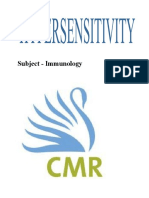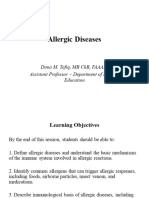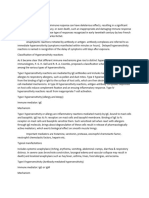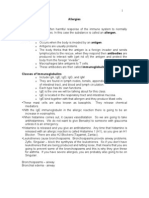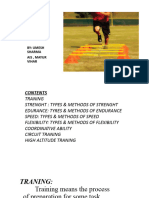0 ratings0% found this document useful (0 votes)
Immunologic Disorder Day 3 (AutoRecovered)
Immunologic Disorder Day 3 (AutoRecovered)
Uploaded by
IRISH CHEEN PARREÑO NACIONALAn immunologic disorder refers to diseases caused by issues within the immune system, including excesses or deficiencies of immune cells or inappropriate responses to antigens. Hypersensitivity is an excessive immune response, usually occurring upon re-exposure to an allergen after sensitization. There are four types of hypersensitivity reactions: Type I is anaphylaxis mediated by IgE antibodies and characterized by edema and bronchospasm; Type II involves IgG/IgM antibodies and can cause hemolysis; Type III involves immune complexes and causes conditions like vasculitis; Type IV is cell-mediated and causes delayed reactions. Nursing implications for anaphylaxis include prevention through allergen avoidance, prompt epinephrine treatment, monitoring for worsening symptoms
Copyright:
© All Rights Reserved
Available Formats
Download as DOCX, PDF, TXT or read online from Scribd
Download as docx, pdf, or txt
Immunologic Disorder Day 3 (AutoRecovered)
Immunologic Disorder Day 3 (AutoRecovered)
Uploaded by
IRISH CHEEN PARREÑO NACIONAL0 ratings0% found this document useful (0 votes)
An immunologic disorder refers to diseases caused by issues within the immune system, including excesses or deficiencies of immune cells or inappropriate responses to antigens. Hypersensitivity is an excessive immune response, usually occurring upon re-exposure to an allergen after sensitization. There are four types of hypersensitivity reactions: Type I is anaphylaxis mediated by IgE antibodies and characterized by edema and bronchospasm; Type II involves IgG/IgM antibodies and can cause hemolysis; Type III involves immune complexes and causes conditions like vasculitis; Type IV is cell-mediated and causes delayed reactions. Nursing implications for anaphylaxis include prevention through allergen avoidance, prompt epinephrine treatment, monitoring for worsening symptoms
Original Description:
immunologic disorder
Original Title
Immunologic disorder Day 3 (AutoRecovered)
Copyright
© © All Rights Reserved
Available Formats
DOCX, PDF, TXT or read online from Scribd
Share this document
Did you find this document useful?
Is this content inappropriate?
An immunologic disorder refers to diseases caused by issues within the immune system, including excesses or deficiencies of immune cells or inappropriate responses to antigens. Hypersensitivity is an excessive immune response, usually occurring upon re-exposure to an allergen after sensitization. There are four types of hypersensitivity reactions: Type I is anaphylaxis mediated by IgE antibodies and characterized by edema and bronchospasm; Type II involves IgG/IgM antibodies and can cause hemolysis; Type III involves immune complexes and causes conditions like vasculitis; Type IV is cell-mediated and causes delayed reactions. Nursing implications for anaphylaxis include prevention through allergen avoidance, prompt epinephrine treatment, monitoring for worsening symptoms
Copyright:
© All Rights Reserved
Available Formats
Download as DOCX, PDF, TXT or read online from Scribd
Download as docx, pdf, or txt
0 ratings0% found this document useful (0 votes)
Immunologic Disorder Day 3 (AutoRecovered)
Immunologic Disorder Day 3 (AutoRecovered)
Uploaded by
IRISH CHEEN PARREÑO NACIONALAn immunologic disorder refers to diseases caused by issues within the immune system, including excesses or deficiencies of immune cells or inappropriate responses to antigens. Hypersensitivity is an excessive immune response, usually occurring upon re-exposure to an allergen after sensitization. There are four types of hypersensitivity reactions: Type I is anaphylaxis mediated by IgE antibodies and characterized by edema and bronchospasm; Type II involves IgG/IgM antibodies and can cause hemolysis; Type III involves immune complexes and causes conditions like vasculitis; Type IV is cell-mediated and causes delayed reactions. Nursing implications for anaphylaxis include prevention through allergen avoidance, prompt epinephrine treatment, monitoring for worsening symptoms
Copyright:
© All Rights Reserved
Available Formats
Download as DOCX, PDF, TXT or read online from Scribd
Download as docx, pdf, or txt
You are on page 1/ 3
Immunologic disorder
A. Immunopathology Type 4 – delayed and cell mediated
> refers to the study of diseases that result from >delayed reaction.
dysfunctions within the immune system
> excesses or deficiencies of immunocompetent Type I Hypersensitivity: Anaphylaxis
cells, alterations in the function of these cells,
immunologic attack on self- antigens, or - Mediated by IgE antibody
inappropriate or exaggerated responses to - it is an immediate reaction beginning within
specific antigens minutes of exposure to an antigen
- most severe hypersensitivity reaction is
Hypersensitivity anaphylaxis characterized by edema in many
- is an excessive or aberrant immune response tissues, including the larynx, and is often
to any type of stimulus accompanied by hypotension, bronchospasm,
- usually does not occur with the first exposure and cardiovascular collapse in severe cases
to an allergen. Rather, the reaction follows a re- - Antibiotics and radiocontrast agents cause the
exposure after sensitization, or buildup of most serious anaphylactic reactions
antibodies, in a predisposed person - Type I hypersensitivity reactions may include
both local and systemic anaphylaxis
Characterized by edema, bronchospasm that
may cause difficulty of breathing.
- Most allergic reactions are either type I or type
IV hypersensitivity reactions
type I – anaphylaxis
allergic asthma- allergy to dust, paint, smell can
trigger, odors can trigger
Hay Fever –
Skin reaction – bitten by tics, spiders, bee stings
can cause anaphylactic shock
Type II – IgG / IgM
Im its is immune it can be thrombocytopenia
Reactions under type 2 is very fatal that can kill
the patients may cause hemolisis (death of
blood cells or bleeding)
Type 3 – immune complex (are antigen comes
from antibody microphage that eats the virus)
mediator is the genes.
Vasculitis – attacks the veins
Serum sickness immune disease
- > 200 KU/L
Serologin test (?) Skin testing
- the intradermal injection of solutions at
Bronchodilators – steroids, antihistamine several sites
Trichiostomy (?) - Positive (wheal-and-flare) reactions are
clinically
Nursing Implications of Anaphylactic (Type I) significant when correlated with the history,
Hypersensitivity physical findings, and results of other laboratory
tests -Skin testing is considered the most
Assessment: accurate confirmation of allergy.
- comprehensive allergy history and a thorough
physical examination -degree of difficulty and
discomfort experienced by the patient because
of allergic symptoms
- degree of improvement in those symptoms
with and without
treatment are assessed and documented
erethema
Sugar doesn’t help in allergic reaction
Type I Hypersensitivity: Nursing Implications
Diagnostic Evaluation : Erethema - allergic reaction during skin testing
Complete Blood Count With Differential
- WBC count is usually normal except with
infection and inflammation
Eosinophil Count
- greater than 5% to 10%
Total Serum Immunoglobulin E Levels
- High total serum IgE levels support the
diagnosis of allergic disease
Prevention: - instructs the patient and family in the use of
- Strict avoidance of potential allergens prescribed Epi-pen and has the patient and
- auto-injector system for epinephrine will be family demonstrate correct administration
prescribed to the pt
- Screening for allergies before a medication is 2. Cytotoxic (Type II) Hypersensitivity
prescribed
- history of any sensitivity to suspected antigens
must be obtained before administering any
medication, particularly in parenteral form,
because this route is associated with the most
severe anaphylaxis in pts
- instruct pt to wear medical identification such
as a bracelet or necklace, which names allergies
to medications, food, and other substances
- venom immunotherapy, which is used as a
control measure and not a cure for people who
are allergic to insect venom
- Desensitization to insulin-allergic patients with
diabetes and those who are allergic to penicillin
Medical management
- If the patient is in cardiac arrest,
cardiopulmonary resuscitation (CPR)
- if the patient is cyanotic, dyspneic, or
wheezing. We inject Epinephrine
- Antihistamines and corticosteroids are given as
adjunct therapy
- Intravenous fluids (e.g., normal saline
solution), volume expanders, and vasopressor
agents are given to maintain blood pressure and
normal hemodynamic status
Nursing Management
- assesses the patient for signs and symptoms of
anaphylaxis. Airway, breathing pattern, and vital
signs if there is vasoconstriction we give
vasodilation.
- observed for signs of increasing edema and
respiratory distress
- Prompt notification of the rapid response
team, the provider, or both are required -
document the interventions used and the
patient’s vital signs and response to treatment
- instructed pt about antigens that should be
avoided and about other strategies to prevent
recurrence of anaphylaxis
You might also like
- Chapter 11 Undesirable and Alteted ImmunityNo ratings yetChapter 11 Undesirable and Alteted Immunity154 pages
- Nursing Care of Clients With Allergic DisordersNo ratings yetNursing Care of Clients With Allergic Disorders12 pages
- Prelims - GMJ RLE - Module 2 III DisorderNo ratings yetPrelims - GMJ RLE - Module 2 III Disorder4 pages
- Hypersensitivity Nursing Students (BSC Nursing)No ratings yetHypersensitivity Nursing Students (BSC Nursing)25 pages
- 20223microlab Activity 9 Hypersensitivty ReactionsNo ratings yet20223microlab Activity 9 Hypersensitivty Reactions6 pages
- Type I Hypersensitivity Reaction - StatPearls - NCBI BookshelfNo ratings yetType I Hypersensitivity Reaction - StatPearls - NCBI Bookshelf13 pages
- Hypersensitivity To Drugs and Their Mechanisms: Name: Mellya Rizki Pitriani Student ID: B1B017031No ratings yetHypersensitivity To Drugs and Their Mechanisms: Name: Mellya Rizki Pitriani Student ID: B1B01703110 pages
- Chapter 11 Undisarable and Alterd ImmunotyNo ratings yetChapter 11 Undisarable and Alterd Immunoty81 pages
- Common Immunologic and Inflammatory Conditions: Asterlyn T. Coniendo Bsn-IvNo ratings yetCommon Immunologic and Inflammatory Conditions: Asterlyn T. Coniendo Bsn-Iv33 pages
- Drug Allergy: Divya Seth, MD and Deepak Kamat, MD, PHDNo ratings yetDrug Allergy: Divya Seth, MD and Deepak Kamat, MD, PHD7 pages
- Mechanisms of Hypersensitivity I, II, III and IVNo ratings yetMechanisms of Hypersensitivity I, II, III and IV37 pages
- Figure 12.2there Are Four Types of Hypersensitivity Reaction Mediated by Immunological Mechanisms That Cause Tissue DamageNo ratings yetFigure 12.2there Are Four Types of Hypersensitivity Reaction Mediated by Immunological Mechanisms That Cause Tissue Damage11 pages
- Chapter IIb - Clinical Immunology UG Med StudentsNo ratings yetChapter IIb - Clinical Immunology UG Med Students251 pages
- Hypersensitivity (Part I) 20235271431440No ratings yetHypersensitivity (Part I) 2023527143144025 pages
- Holistic Allergy Management: Self-Care, Diet, and HomeopathyFrom EverandHolistic Allergy Management: Self-Care, Diet, and HomeopathyNo ratings yet
- Adult ( 18 Years) Asthma Quick Reference Guide (Update Nov 2017)No ratings yetAdult ( 18 Years) Asthma Quick Reference Guide (Update Nov 2017)2 pages
- Module 7 Mental Health and Wellbeing in Middle and Late AdolescenceNo ratings yetModule 7 Mental Health and Wellbeing in Middle and Late Adolescence5 pages
- Introduction To Project Planning-For AH & DVMNo ratings yetIntroduction To Project Planning-For AH & DVM12 pages
- Practical Research 2: Vinz Oliver A. Pedrano Grade 12 - STEM 1No ratings yetPractical Research 2: Vinz Oliver A. Pedrano Grade 12 - STEM 19 pages
- Scientometrics_Scoping Review_Agarwal V8.0No ratings yetScientometrics_Scoping Review_Agarwal V8.038 pages
- Limited Impact of Cannabidiol On Health-Related Quality of Life of People With Long-Term Controlled HIV: A Double-Blind, Randomized, Controlled TrialNo ratings yetLimited Impact of Cannabidiol On Health-Related Quality of Life of People With Long-Term Controlled HIV: A Double-Blind, Randomized, Controlled Trial9 pages
- 4life Resources Product Catalog EnglishNo ratings yet4life Resources Product Catalog English56 pages
- Sf2_2024_grade 8 (Year II) - Aquino NovemberNo ratings yetSf2_2024_grade 8 (Year II) - Aquino November3 pages
- Develop Jedi Self-Confidence - Unleash The Force Within YouNo ratings yetDevelop Jedi Self-Confidence - Unleash The Force Within You119 pages
- Shenes Thompson Final Draft For Ethical ApprovalNo ratings yetShenes Thompson Final Draft For Ethical Approval36 pages
- PDF Makalah Telenursing Dalam KeperawatanNo ratings yetPDF Makalah Telenursing Dalam Keperawatan24 pages
- 29._June_2024 BPAS-186 IGNOUAssignmentGuru.comNo ratings yet29._June_2024 BPAS-186 IGNOUAssignmentGuru.com4 pages
- The Care of Congenital Myopathy: A Guide For Families. CMFG-2018-9-29 Update (Web Quality)No ratings yetThe Care of Congenital Myopathy: A Guide For Families. CMFG-2018-9-29 Update (Web Quality)105 pages
- Beat The Apocalypse Full Home Gym: (Barbell, Rack, Bench, Moderate Db/Optional)0% (1)Beat The Apocalypse Full Home Gym: (Barbell, Rack, Bench, Moderate Db/Optional)8 pages






















